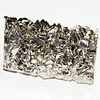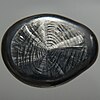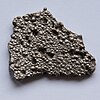Metale nieżelazne
Metale nieżelazne (metale kolorowe) – nazwa techniczna metali innych niż żelazo i stopów metali niezawierających żelaza[1][2]. Do metali kolorowych zalicza się m.in. miedź, cynk, cynę, ołów i aluminium, a do stopów mosiądz i brąz. Są to ciała o charakterystycznym połysku, są dobrymi przewodnikami cieplnymi.
Mają różnorodne właściwości fizyczne, chemiczne, mechaniczne i technologiczne, i z tego powodu są powszechnie stosowane w wielu dziedzinach techniki[3].
Rodzaje
Metale nieżelazne i ich stopy można podzielić na główne grupy[3]:
Metale lekkie
| Rodzaj | Ilustracja | Nazwa metalu | Temperatura topnienia | Gęstość (g/cm³) |
|---|---|---|---|---|
| łatwo topliwe |  | magnez | 650 | 1,74 |
 | aluminium | 660 | 2,70 | |
| trudno topliwe |  | tytan | 1820 | 4,54 |
| źródło:[4] | ||||
Metale ciężkie
| Rodzaj | Ilustracja | Nazwa metalu | Temperatura topnienia | Gęstość (g/cm³) |
|---|---|---|---|---|
| łatwo topliwe |  | cynk | 419,5 | 7,133 |
 | kadm | 320,0 | 8,65 | |
 | cyna | 231,9 | 7,30 | |
 | ołów | 327,4 | 11,34 | |
 | bizmut | 271,3 | 9,80 | |
| trudno topliwe |  | cyrkon | 1852 | 6,49 |
 | kobalt | 1445 | 8,9 | |
 | nikiel | 1455 | 8,9 | |
 | miedź | 1083 | 8,96 | |
 | pallad | 1554 | 12,0 | |
 | srebro | 960 | 10,49 | |
 | platyna | 1773,5 | 21,45 | |
(c) Rob Lavinsky, iRocks.com – CC-BY-SA-3.0 | złoto | 1063,0 | 19,32 | |
| bardzo trudno topliwe |  | molibden | 2665 | 10,2 |
 | tantal | 2996 | 16,6 | |
 | wolfram | 3410 | 19,3 | |
| źródło: [4] | ||||
Przypisy
- ↑ metale. W: Mały słownik chemiczny. Jerzy Chodkowski (red.). Wyd. V. Warszawa: Wiedza Powszechna, 1976, s. 321–322.
- ↑ metale kolorowe, nieżelazne. W: Słownik języka polskiego [on-line]. PWN. [dostęp 2015-12-07].
- ↑ a b Materiały nieżelazne (pol.). E-spawalnik.pl. [dostęp 2015-01-21].
- ↑ a b Maria Głowacka(red.): Metaloznawstwo. Gdańsk: Politechnika Gdańska, 1996, s. 12. ISBN 83-86537-39-6.
Media użyte na tej stronie
Autor:
Hi-Res Images of
Chemical Elements, Licencja: CC BY 3.0Molybdenum is one of the most heavy elements of those essential to life. Most remarkable is the enzyme nitrogenase with molybdenum in its active center, which allows some bacteria to process nitrogen from the air. In elemental form, the hard, heavy and ductile metal is used for many special technical applications, like for the tempering of steel.
Autor: Alchemist-hp (talk) (www.pse-mendelejew.de), Licencja: FAL
Czysta (99,9 %) konkrecja niklu rafinowanego elektrolitycznie oraz sześcian (1 cm3) wykonany z niklu o czystości (99,99 % = 4N).
* Bildbeschreibung: hochreines Tantal
- Quelle: selbst fotografiert, Material: Heinrich Pniok http://www.pniok.de
- Fotograf: Tomihahndorf
- Datum: März 2006
Autor:
Hi-Res Images of
Chemical Elements, Licencja: CC BY 3.0Titanium is a grey, light, but very strong metal. Is is quite frequent, but hard to extract, which makes the pure metal fairly expensive. It is used a lot for technical components and steels. Much better available than the metal itself is titanium dioxide, TiO2, the most widely used white pigment, which you can see on nearly every white painted wall. Titanium dioxide is one of the thermic most enduring molecules and one of only a few that can be found in some stars.
Autor: Alchemist-hp (talk) (www.pse-mendelejew.de), Licencja: FAL
Samorodek platyny z kopalni w masywie Kondjor (Kraj Chabarowski, Rosja). Wymiary ok. 35 × 23 × 14 mm, masa ok 112 g. Kolekcja M. R.
Autor:
Hi-Res Images of
Chemical Elements, Licencja: CC BY 3.0Tin is a very common metal. It is soft and has a low melting point, which makes it a very good workable material, that is used since ancient times. Bronze is usually an alloy of copper and tin. The common β-tin can transform into powdery α-tin at low temperatures (below 13°C, 56°F). This is known as tin pest, which destroys the affected item.
Autor:
- Native_Copper_Macro_Digon3.jpg: “Jonathan Zander (Digon3)"
- derivative work: Materialscientist (talk)
Makro miedzi rodzimej rozmiar około 1 ½ cala (4 cm)
Zinc sample
Autor: Warut Roonguthai, Licencja: CC BY-SA 3.0
A chunk of vapor-deposited magnesium crystals produced by the Pidgeon process at a refinery in China. Its maximum dimension is about 24 cm long.
Autor: Nieznany, Licencja: CC BY 1.0
Pure cadmium. Original size of each piece in cm: about 1
(c) Rob Lavinsky, iRocks.com – CC-BY-SA-3.0
Gold
- Locality: Alaska, USA (Locality at mindat.org)
- A hefty 63.8-gram gold nugget, shaped like a pancake. Very beautiful and classic locality nugget. 4.5 x 3 x 0.6 cm
Autor: Autor nie został podany w rozpoznawalny automatycznie sposób. Założono, że to Ytrottier (w oparciu o szablon praw autorskich)., Licencja: CC-BY-SA-3.0
Bismuth crystal, photo taken by Yannick Trottier, 2005



















